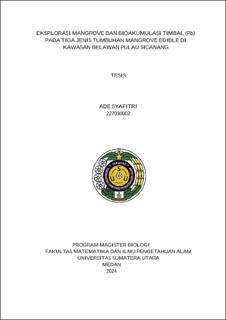| dc.description.abstract | Lead (Pb) is one type of heavy metal that can interfere with human health. Mangrove vegetation has the ability to accumulate heavy metals, among other Pb found in the environment. Sicanang Island is an area surrounded by water, a vast mangrove expanse, and close to an industrial area. The study aims to identify and describe the morphological characteristics of mangrove plant species in Belawan Island Sicanang, analyze lead content (Pb) in water, sediments, roots, leaves, stems, and fruits of plants Acanthus ilicifolius, Nypa fruticans, and Sonneratia alba, as well as to analyze the values of lead biocentration factors (BCF) in plants A. ilicifolia, N. fruticans, and S. alba. The results show that there are 29 species of mangrove plants in Belawan Sicanang Island that fall into 23 genuine mangrove species and 6 follow-up mangrove varieties. Pb concentrations in water samples at four stations have the same concentration of 0.003 mg/kg and do not exceed the standard quality limit (0.008 mg/l). The highest concentrations of Pb in sediment samples in Stations I, III, IV, II and falling into the lowest category do not transcend the standard raw quality threshold. Pb N. fruticans and S. alba at all four stations exceeded the standard quality threshold (0.15–1.0 mg/kg). BCF values at stations I, II, III, and IV overall in plants A. ilicifolius, N. fruticans, and S. alba have a BCF value < 1 and fall into the excluder category. | en_US |


